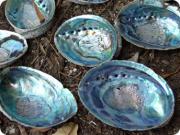Radio Program
Our regular Science and the SeaTM radio program presents marine science topics in an engaging two-minute story format. Our script writers gather ideas for the radio program from the University of Texas Marine Science Institute's researchers and from our very popular college class, Introduction to Oceanography, which we teach to hundreds of non-science majors at The University of Texas at Austin every year. Our radio programs are distributed at to commercial and public radio stations across the country.
Porpoises and dolphins are a common sight for boaters along much of the world’s coastlines. They love to race along near the bow of a boat, putting on a show as they jump free of the waves.
One exception is the vaquita -- a name that means “little cow.” It’s a porpoise that’s found only in the Sea of Cortez, which is between Baja California and the Mexican mainland.
In 1940, novelist John Steinbeck sailed into the Gulf of California with his friend, marine scientist Edward Ricketts. They cruised the gulf for six weeks, gathering scientific samples, doing a little fishing, and enjoying the gulf’s tranquil beauty. Their work provided the first in-depth look at life in the gulf. And the two books they published popularized another name for it: the Sea of Cortez.
Off the coast of Norway, a mile-wide volcano spits out mud and methane -- a greenhouse gas that could increase global warming. Near the Azores islands, “chimneys” pump 500-degree water into the Atlantic, feeding colonies of algae, shrimp, and other organisms. And beneath the Sea of Marmara, an active fault line triggers deadly earthquakes across Turkey.
If there’s one thing the fish known as Macropinna microstoma doesn’t have to worry about, it’s being hit in the head by a falling brick. Its tube-shaped eyes typically look straight up -- through the transparent top of its own head. But it can also rotate its eyes so they look forward -- through organs that are the equivalent of nostrils.
Macropinna is found along the rim of the northern Pacific Ocean, from Japan to the Bering Sea to Baja California.
Cape Hatteras. Hilton Head. Miami Beach. Galveston. South Padre.
Not only are these some of the most popular tourist destinations in the country, they’re some of the most fragile, too. Their contours are constantly reshaped by wind and waves and storms -- the fate of all barrier islands.
These islands are long, narrow strips of sand that run parallel to the coastline. They’re found along all the world’s coastlines. But they’re most prominent on the Atlantic and Gulf coasts of the United States.
Just because something is beautiful doesn’t mean it can’t be tough. Consider mother of pearl -- the irridescent coating on the insides of the shells of some oysters, abalone, and other creatures. Its colorful appearance belies the fact that it’s extremely tough -- about 3,000 times stronger than its individual pieces. Scientists and engineers hope to emulate that toughness in designs for everything from body armor to artificial bones.
If you ever want to drop a boat in the water and let the currents carry you around the world, there’s only one place to go: Antarctica. A wide, deep current circles the entire continent. It’s the only current that will carry you all the way around the globe.
The Antarctic Circumpolar Current was discovered more than three centuries ago by Edmond Halley, for whom Halley’s Comet is named. But scientists didn’t begin to study the current until the last half of the 20th century.
In aquariums and water shows, the Orca looks cute and cuddly. Its streamlined shape, black-and-white coloring, and strong leaps make it a popular performer. But in the wild, it earns its nickname: killer whale. It hunts in packs, and eats just about anything that swims or floats. And it doesn’t matter how big the prey is -- Orcas will attack whales that are many times their own size.
A volcanic mountain is building off the coast of Oregon. It sits atop a “hotspot” -- a bubble of hot rock far beneath the ocean floor. The lava pushes through the plate of rock that forms the Pacific basin, and piles up to form a mountain.
It’s a process that’s played out many times over the last 40 million years or so. It’s built up an entire chain of submerged mountains, known as seamounts. They stretch hundreds of miles to the northwest, far into the Gulf of Alaska. Some of them rise up to two miles high, and come to within a few hundred feet of the surface.
From its name to its feeding habits, the hagfish is one of the least appealing creatures in the sea.
Its long, thin body looks like a fat worm -- and early researchers even classified it as a worm. It burrows into the ooze at the bottom of the ocean, usually waiting for a dead or dying animal to fall from above. And when one does, it burrows into the creature and eats it from the inside out.


